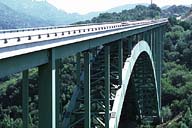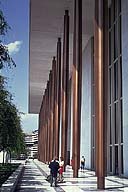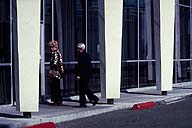
|
Image-GoddenF33
Tall crane on a building site. The jib of this crane is an example of a column, hinged at both ends, subjected to axial loading. The value of transverse loading due to self weight depends on the angle of the jib.
|
|

|
Image-GoddenF34
Dome of Discovery. Constructed for the Festival of Britain in 1947, this dome was supported by a series of sloping columns holding the ring beam. The columns were tapered truss members, triangular in section, and pinned at both ends. The building has since been dismantled. (London, England)
|
|

|
Image-GoddenF35
Detail of the Dome of Discovery showing the hinge support at the column base. (London, England)
|
|

|
Image-GoddenF36
Cold Springs Canyon Bridge. This 1200 ft steel arch highway bridge has spandrel columns between the deck level beams and arch ribs that are hinged at both ends. This is an example of the use of hinged-hinged columns of constant section used in bridge design practice. See also GoddenB43.8-B43.9. (Near Santa Barbara, California)
|
|

|
Image-GoddenF37
John F. Kennedy Center. The outside columns of this building, though not strictly hinged at each end, are designed to have a much reduced bending stiffness at both top and bottom, and hence approximate hinged ends. The columns consist of a central steel pipe with four fins that taper from minimum depth at the ends to maximum at mid-height. (Washington, D.C.)
|
|

|
Image-GoddenF38
Bank building. The columns on the outside of the building that support the roof beams are clearly designed as hinged both top and bottom. As in the structures of GoddenF34 and GoddenF36, the sections are tapered to maximum at mid-height. (Las Vegas, Nevada)
|
|

|
Image-GoddenF39
Bank building. Detail of the bottom of the column. The central core of the reinforced concrete column is a steel tube that on its own acts as the minimum section at the ends of the columns, and also acts as a drainage duct. (Las Vegas, Nevada)
|
|









